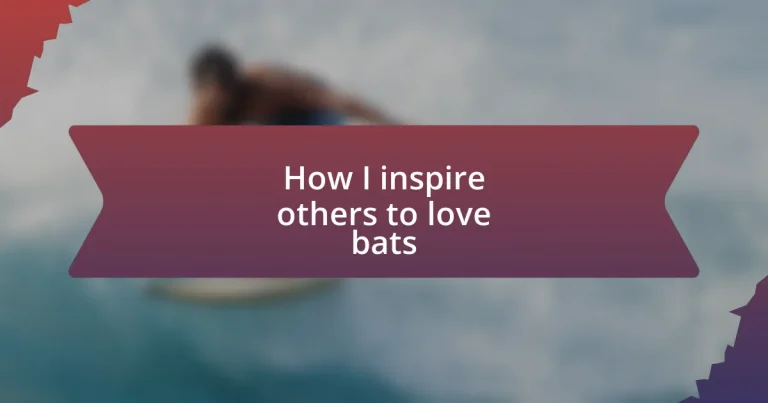Key takeaways:
- The author’s passion for bats was ignited through personal experiences, including holding a bat and observing their roles in the ecosystem.
- Bats provide critical benefits such as natural pest control, pollination, and seed dispersal, making them vital to environmental health.
- Community outreach and educational initiatives play a key role in reshaping perceptions and fostering appreciation for bats.
- Social media effectively raises awareness and combats misinformation about bats, creating community engagement around their conservation.
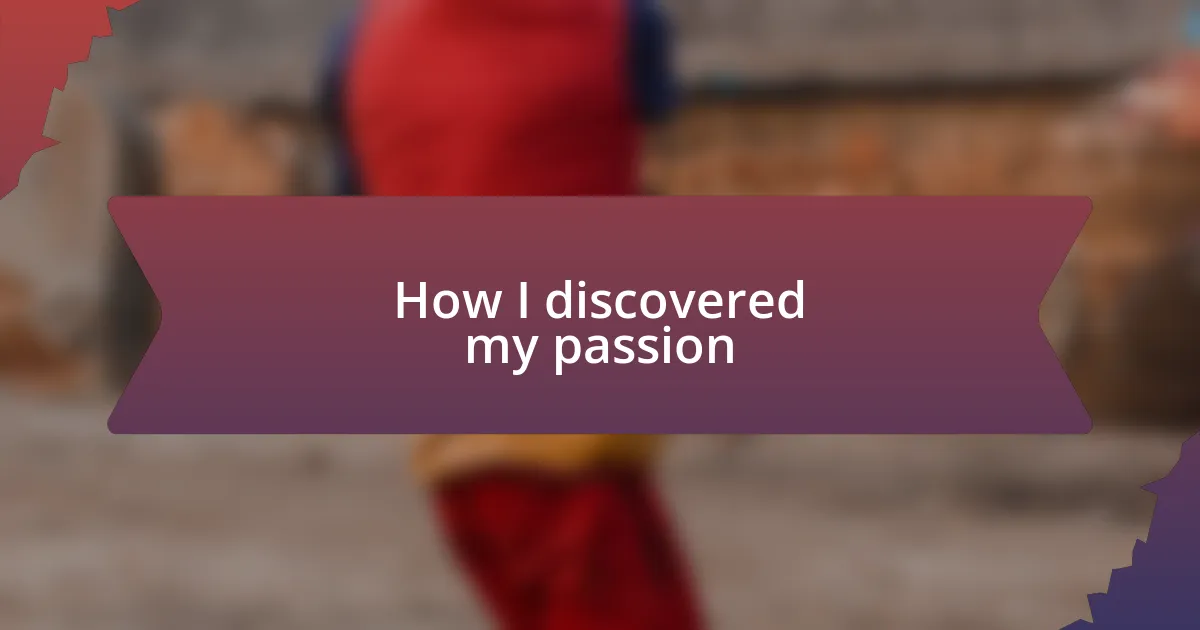
How I discovered my passion
The first time I held a bat was during a local wildlife rehabilitation event, and I was both terrified and fascinated. As I cradled the tiny creature in my hands, I could feel its heartbeat—a reminder that this misunderstood animal was alive, vibrant, and deserving of protection. How could I not fall in love with something so delicate yet resilient?
My journey deepened on a camping trip when the night skies erupted with flitting shadows—bats dancing gracefully against the moonlight. Watching them feed brought an overwhelming sense of joy and connection; I realized these creatures were not the villains of the night but rather the silent guardians of our ecosystems. Have you ever felt that exhilarating moment when you discover something you didn’t know you needed in your life?
Then came the moment of clarity: while volunteering at a bat rescue, I learned the critical role they play in pest control and pollination. I vividly remember a child’s eyes lighting up when I shared this knowledge—seeing their wonder made me realize that I could inspire others, just as I had been inspired. Isn’t that the essence of passion? To share the love and spark a curiosity in others that leads them to appreciate the beauty of bats?
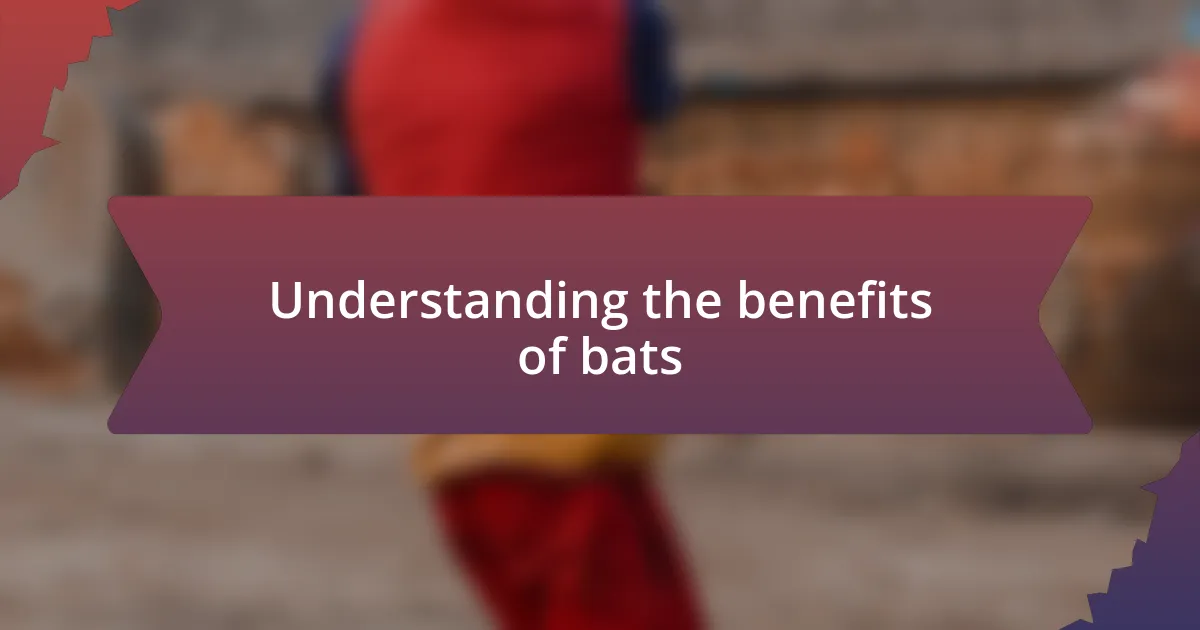
Understanding the benefits of bats
Understanding the benefits of bats
Bats contribute significantly to our ecosystems, and I’ve witnessed this firsthand. During my time observing them, I found that a single bat can eat thousands of insects in just one night. This natural pest control benefits both farmers and homeowners, allowing us to reduce reliance on chemical pesticides that can harm other wildlife.
Here are some key benefits of bats that highlight their importance:
- Pest Control: Bats consume large quantities of insects, helping manage pest populations naturally.
- Pollination: Some bat species are excellent pollinators for fruits like bananas and agave, supporting agriculture.
- Seed Dispersal: Bats help in dispersing seeds over vast areas, which is crucial for forest regeneration.
I remember one particular night I spent outdoors, mesmerized by the sounds of crunching insects evoking the presence of these silent protectors. Each flutter of their wings was a reminder of the delicate balance in nature, and I realized how important it was for us to protect these remarkable creatures.
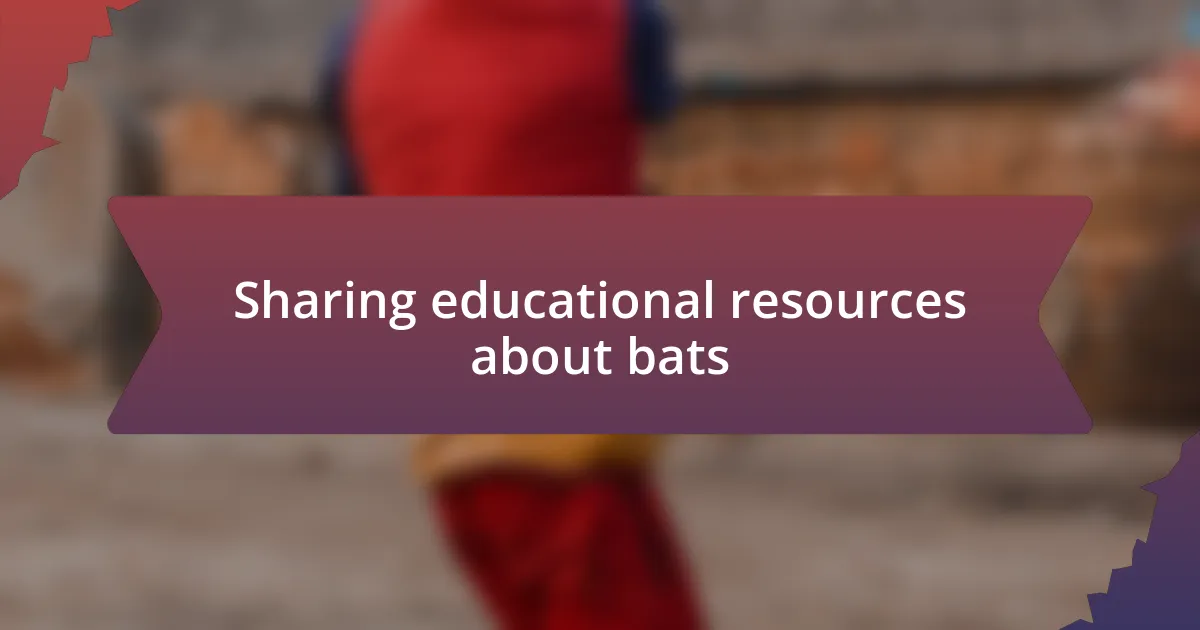
Sharing educational resources about bats
Sharing educational resources about bats is one of the most impactful ways to inspire love and appreciation for these creatures. From documentaries to interactive websites, I have found that diverse formats cater to different learning styles. For instance, while some may prefer watching a captivating documentary showcasing bats in their natural habitat, others might benefit from engaging with hands-on educational kits that provide a tangible connection to these animals.
Last summer, I organized a community event featuring a local wildlife expert who shared fascinating bat facts. The mesmerizing imagery and interactive elements turned initial skepticism into genuine curiosity among attendees. They were not only learning but also engaging in spirited conversations about bats’ vital roles in our ecosystems. Connecting these resources to community activities fosters a sense of discovery and enhances our emotional connections with bats.
In my experience, social media can also serve as an excellent platform for sharing bat-related content. I often come across fantastic infographics and videos that effectively communicate why bats are essential for our environment. By sharing these resources, I find myself not just educating others but also creating a community that celebrates the beauty and importance of bats.
| Resource Type | Example |
|---|---|
| Documentary | Bats: Masters of the Night (Nature) |
| Educational Kit | Bat Box Building Kit |
| Infographic | Bat Facts for Kids |
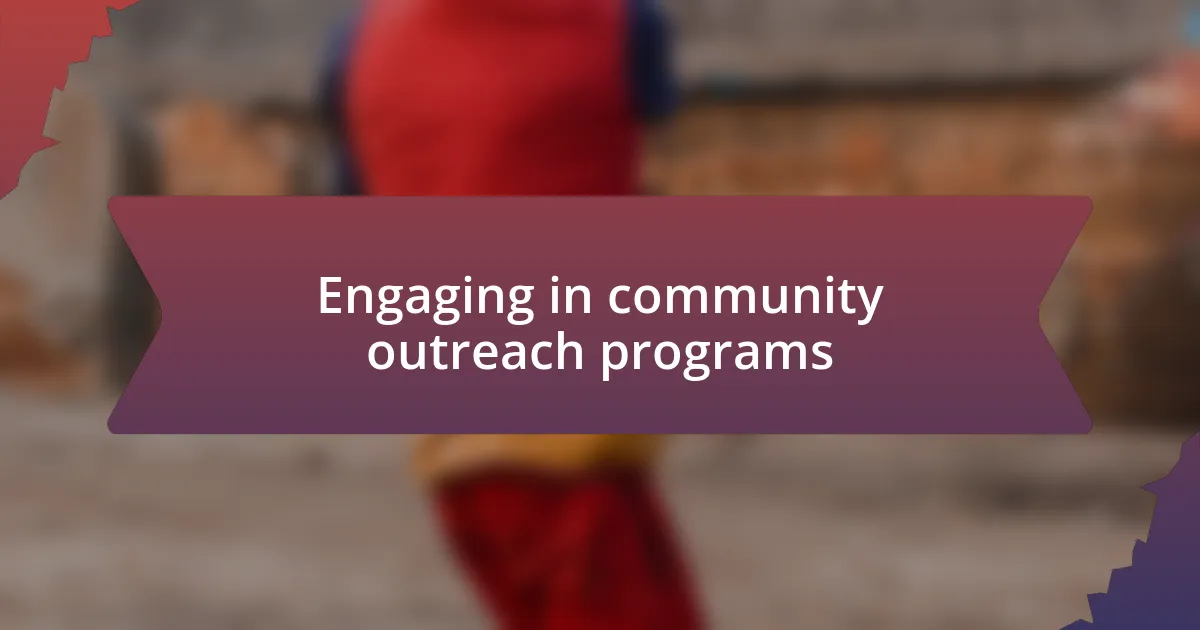
Engaging in community outreach programs
Engaging in community outreach programs has proven to be a transformative experience in fostering a love for bats. Last fall, I initiated a local bat watch event, where families gathered under the stars to witness bats emerge for their nightly feeding. The collective awe and wonder in the air as we observed them swoop and dive was nothing short of magical. It struck me how simple moments like these can shift perceptions—who would have thought the creatures many feared could inspire such joy?
I’ve also found that hosting workshops can significantly enhance community involvement. In a recent workshop, I invited attendees to make bat houses, combining creativity with environmental stewardship. Watching participants’ excitement as they painted their bat houses made me realize how hands-on activities truly connect people to nature. It’s fascinating how the act of crafting can spark a sense of responsibility towards these often-misunderstood animals.
What truly resonates with me is the impact of storytelling during outreach programs. While sharing personal stories about my encounters with bats, I often see eyes widen and smiles form. Have you ever felt a connection while hearing a passionate story? For many, it’s that emotional thread that ties them to the cause. I’ve learned that through sharing everyday tales and experiences, we can collectively reshape the narrative around bats, inspiring others to appreciate them just as deeply as I do.
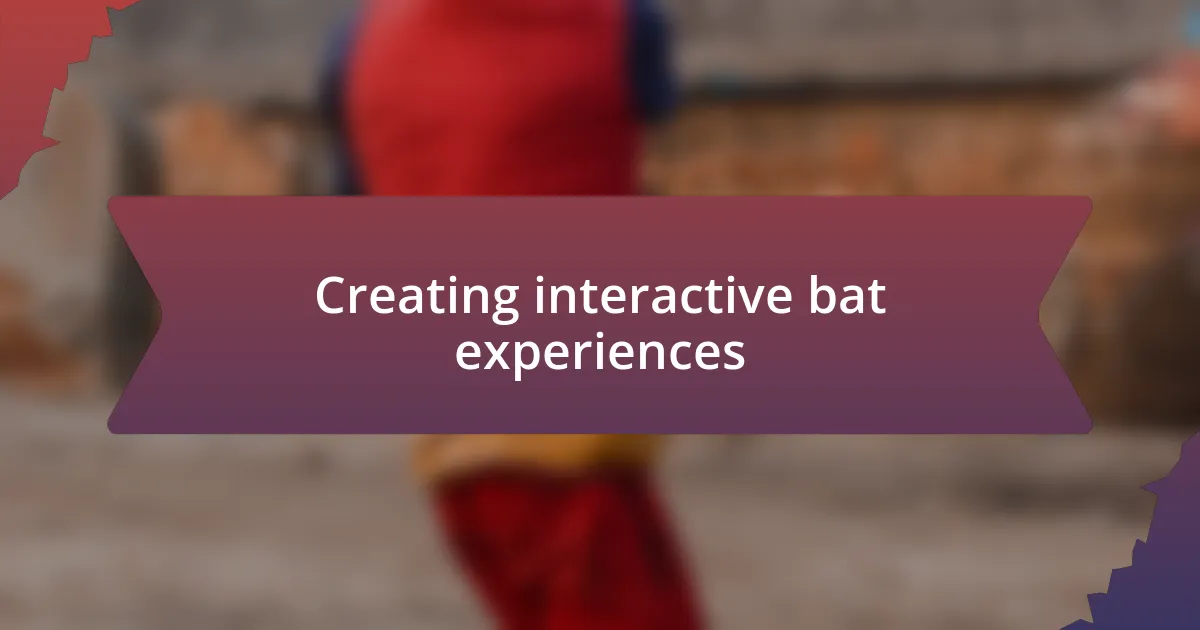
Creating interactive bat experiences
Creating interactive bat experiences allows individuals to connect with these amazing creatures on a deeper level. During one twilight event, I invited local children to use bat detectors that amplified the sounds of their echolocation. The look of wonder on their faces as they heard bats calling was priceless. It’s moments like these that highlight how engaging directly with bats can demystify them and create lasting admiration.
I find that incorporating technology can also enhance these experiences significantly. At a recent event, I set up a virtual reality station where participants could experience a day in the life of a bat. Watching someone don the headset and fly through a digital forest, navigating like a bat, was unforgettable. It sparked conversations about their daily challenges and interesting behaviors, allowing attendees to develop empathy for creatures they previously overlooked. Have you ever realized how a virtual experience can open up real-world understanding?
Also, I encourage creating citizen science projects where community members can contribute to bat monitoring efforts. Once, I organized a local citizen science initiative where families documented bat sightings and behaviors. The excitement of watching families engage in research empowered them, knowing their contributions could help protect bat populations. It reminded me just how much passion can be ignited when people feel they have a stake in preserving biodiversity.
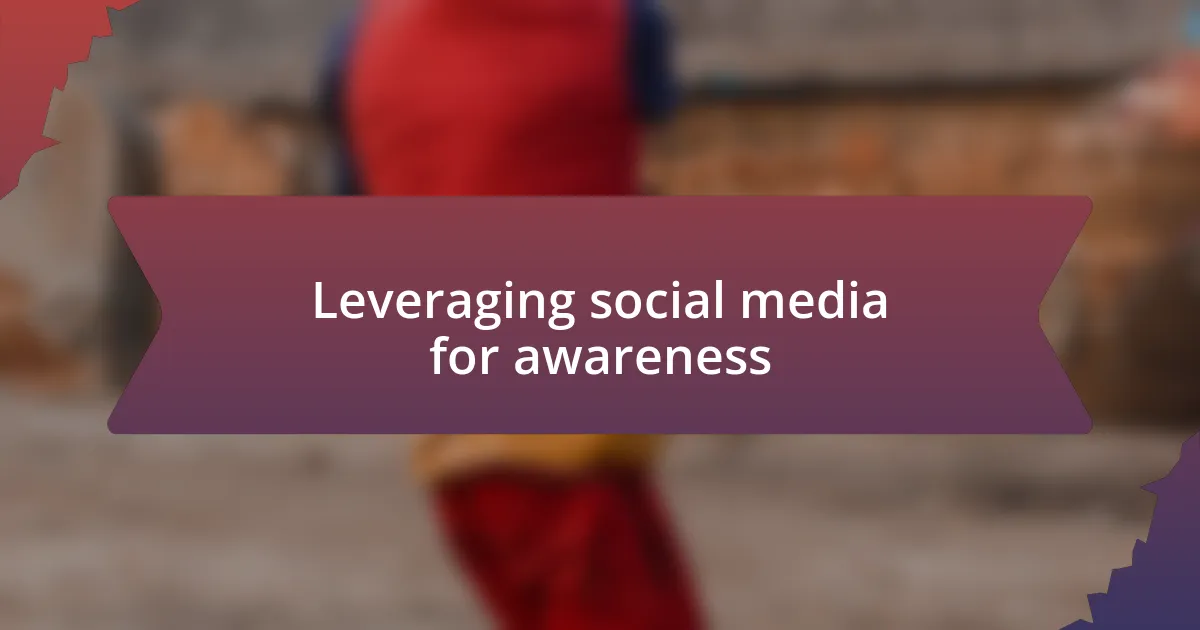
Leveraging social media for awareness
Social media is a powerful tool for raising awareness about bats and their vital roles in our ecosystem. I recall posting a video on Instagram of a bat emerging from its roost at dusk, paired with a caption highlighting their importance in pest control. The responses were overwhelming; people shared their own experiences and even tagged friends, turning a simple post into a lively conversation about a creature often misunderstood.
Engaging visuals can create a lasting impact. I once created a series of infographics detailing bat species present in our area, highlighting their unique attributes and conservation status. As I shared these on Facebook, I was amazed to see how quickly misinformation about bats began to diminish in the comments. This reinforces the importance of accurate, visually engaging content in sparking curiosity and informing the public.
Moreover, hosting live Q&A sessions allows for real-time interaction with the audience. During one such session, I shared my personal journey of becoming a bat enthusiast, illustrating how fascination can lead to advocacy. A viewer asked how they could help local bat populations, prompting discussions about conservation initiatives in our community. This interactive approach not only educates but also builds a community around the shared love for bats. Isn’t it rewarding to see firsthand how a single conversation can inspire someone to take action?
